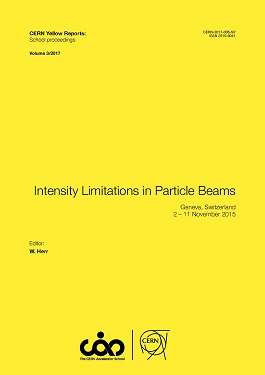Electron Clouds
DOI:
https://doi.org/10.23730/CYRSP-2017-003.411Keywords:
Collective effects, two-stream interactions, heat load, mitigation, scrubbing, coherent instabilities.Abstract
The term ‘electron cloud’ refers to an accumulation of electrons inside the vacuum chamber of a particle accelerator, which is sufficiently strong to produce undesired effects on the accelerator operation, e.g., by causing beam loss, emittance growth, increase in the vacuum pressure, or unacceptable heat load on cold surfaces. Electrons in the beam chamber can primarily be generated by a number of processes, e.g., ionization of the residual gas. Their number, however, can exponentially increase via a beam-induced multipacting mechanism, which relies on acceleration of electrons in the field of the particle beam and efficient secondary emission from their impact on the chamber wall. Several machines running with high-intensity positively charged beams, made of trains of closely spaced bunches, suffer severe effects from electron clouds, and in some cases their performance is even limited by it. Techniques of electron cloud suppression or mitigation exist; the most popular ones are based on the
reduction of the secondary electron yield of the chamber inner surfaces. This can be achieved passively through the so-called process of machine scrubbing, or actively by coating the inner pipe walls with appropriate low secondary electron yield materials.
Downloads
Published
Issue
Section
License
Authors who publish with this publication agree to the following terms:
- CERN retains copyright and publishes the work licensed under the Creative Commons Attribution License 4.0 that allows others to share the work with an acknowledgement of the work's authorship and initial publication in this series.
- Authors are able to enter into separate, additional contractual arrangements for distribution of the published version of the work (e.g., post it to an institutional repository or publish it in a book), with an acknowledgement of its initial publication in this series.
- Authors are permitted and encouraged to post their work online (e.g., in institutional repositories or on their website) prior to and during the submission process, as it can lead to productive exchanges, as well as earlier and greater citation of published work (See The Effect of Open Access).

